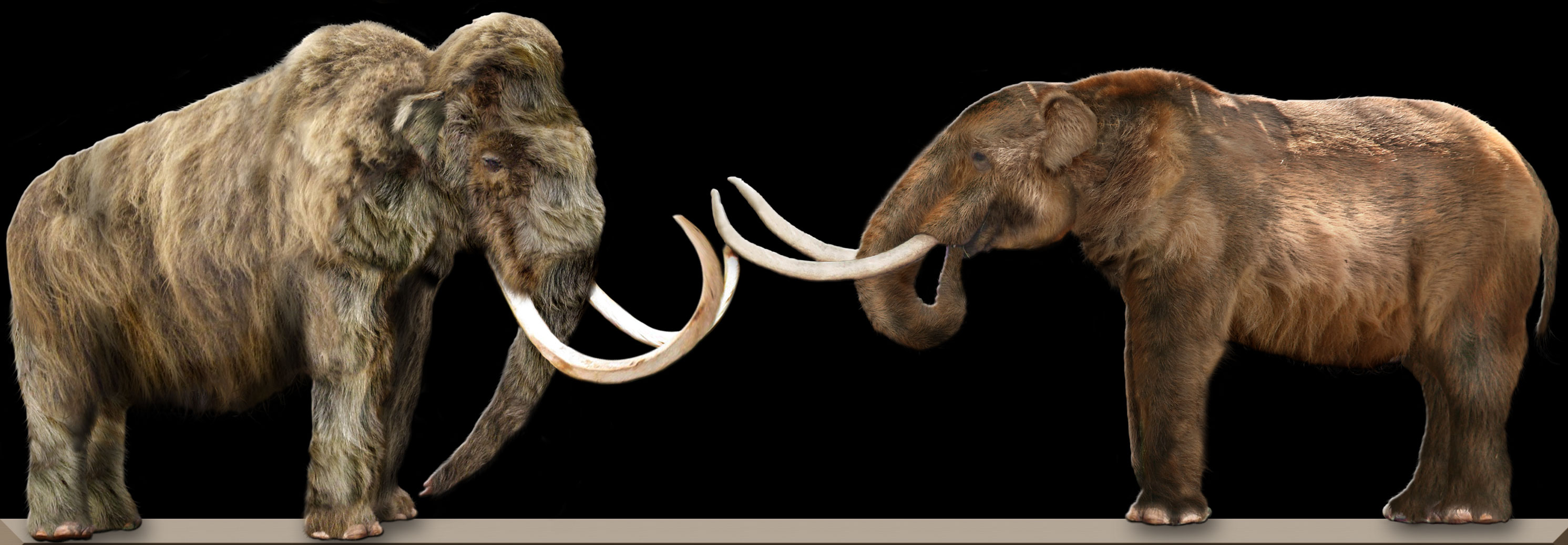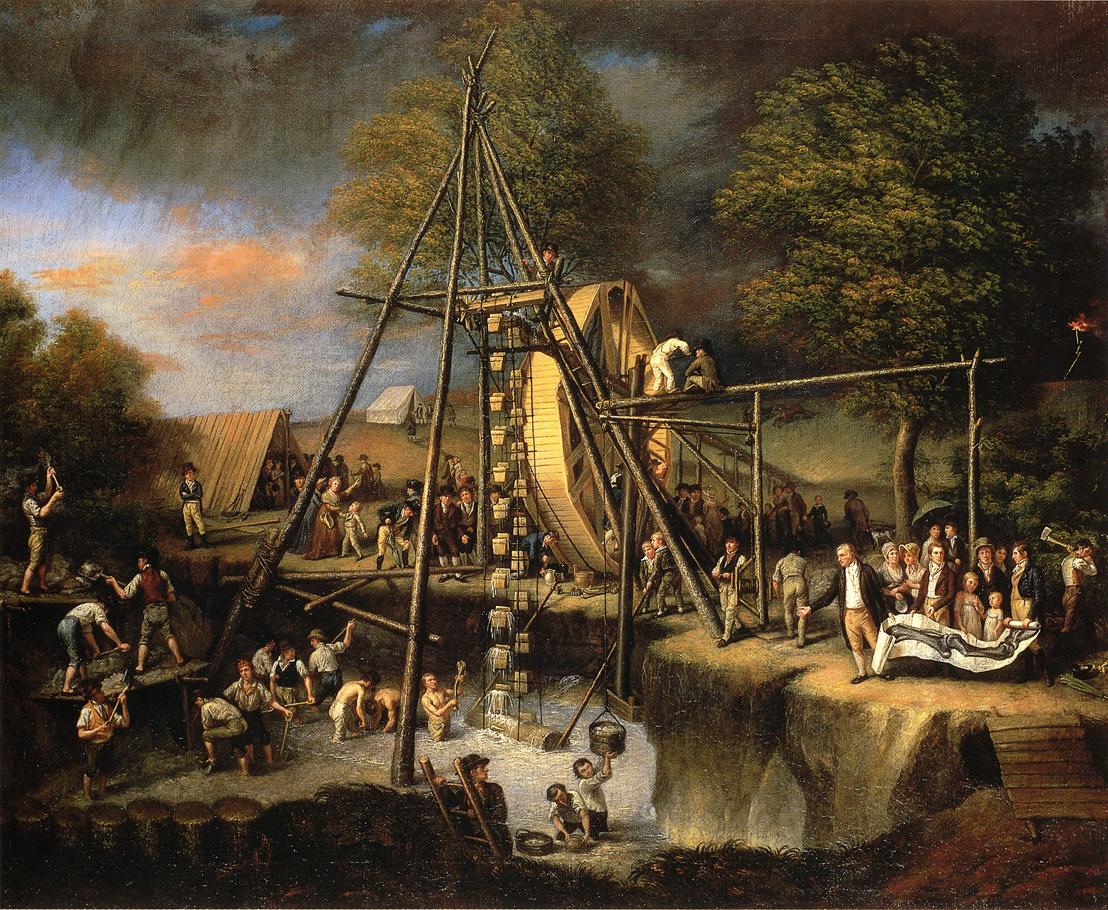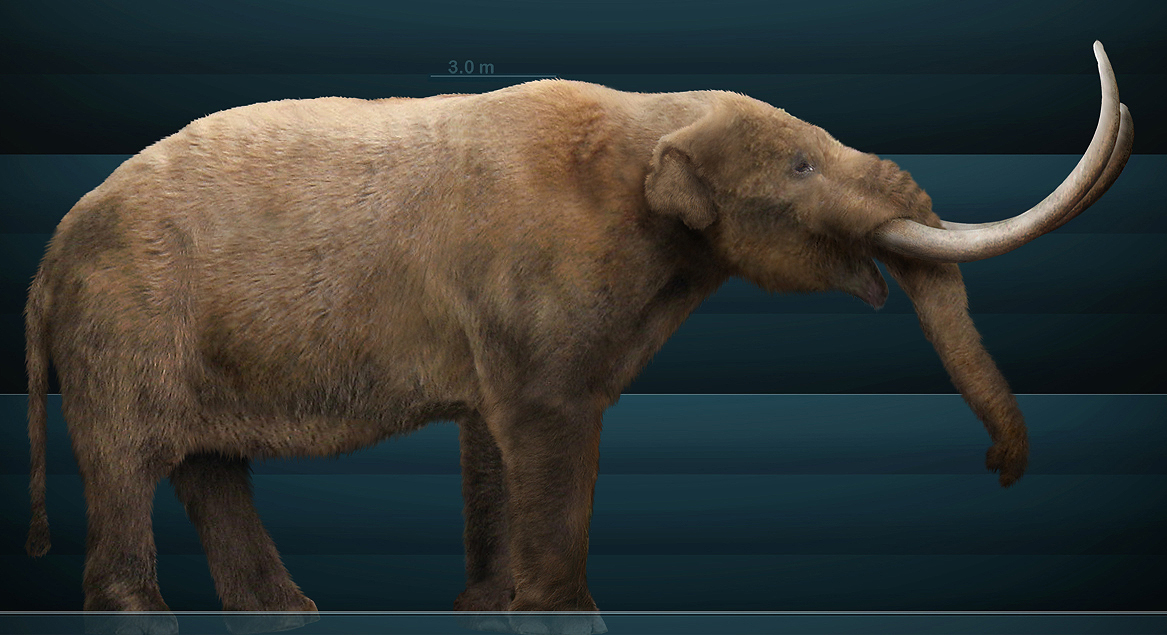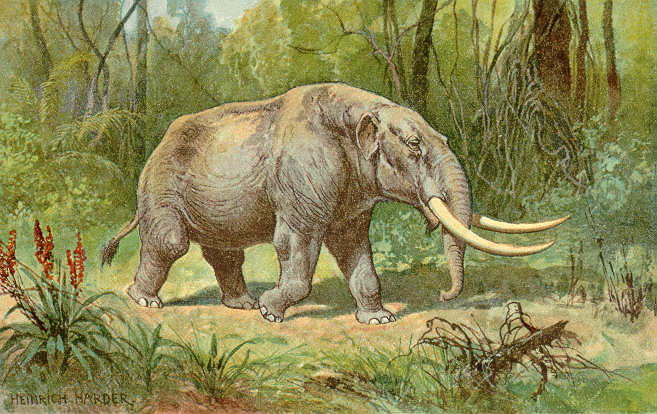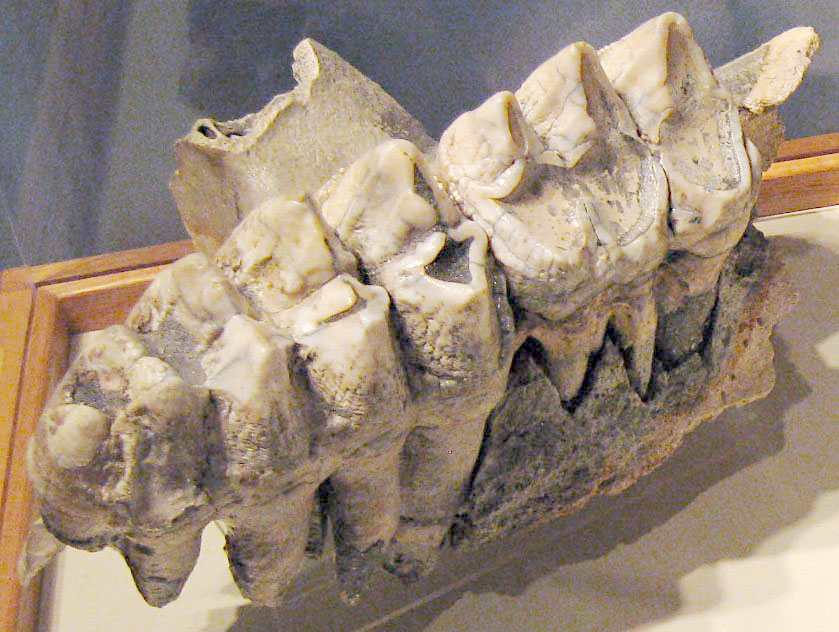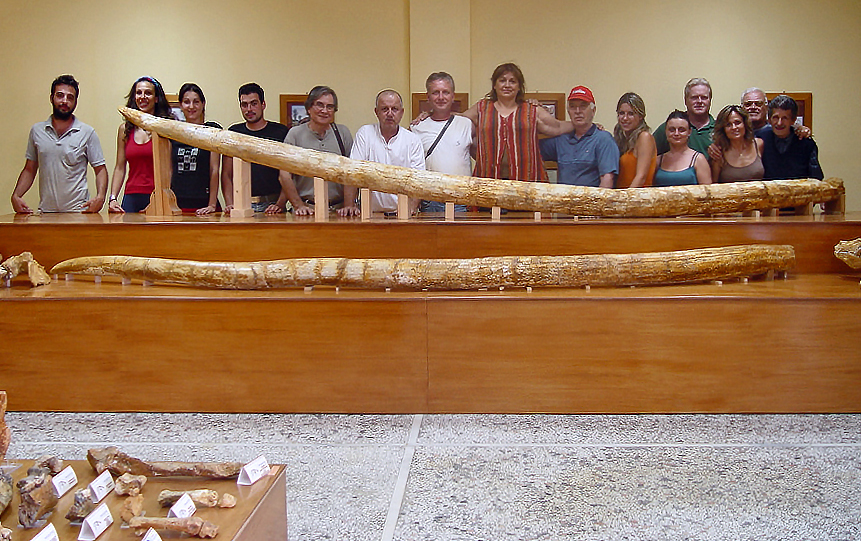|
Mammutidae
Mammutidae is an extinct family of proboscideans that appeared during the Oligocene epoch and survived until the start of the Holocene. The family was first described in 1922, classifying fossil specimens of the type genus ''Mammut'' (mastodons), and has since been placed in various arrangements of the order. The name "mastodon" derives from Greek, "nipple" and "tooth", as with the genus, referring to a characteristic that distinguishes them from allied families. The genus ''Zygolophodon'' has also been assigned to this family. Mammutids ranged very widely, with fossils found in North America, Africa, and throughout Eurasia. Discoveries Since the 18th century several fossils have been found in different regions of Venezuela; the first one of these fossils was reviewed by Alexander von Humboldt. In August 2008, miners in Romania unearthed the skeleton of a 2.5-million-year-old mastodon, believed to be one of the best preserved in Europe. [...More Info...] [...Related Items...] OR: [Wikipedia] [Google] [Baidu] |
Proboscidea
The Proboscidea (; , ) are a taxonomic order of afrotherian mammals containing one living family (Elephantidae) and several extinct families. First described by J. Illiger in 1811, it encompasses the elephants and their close relatives. From the mid-Miocene onwards, most proboscideans were very large. The largest land mammal of all time may have been a proboscidean; ''Palaeoloxodon namadicus'' was up to at the shoulder and may have weighed up to , almost double the weight of some sauropods like ''Diplodocus carnegii''. The largest extant proboscidean is the African bush elephant, with a record of size of at the shoulder and . In addition to their enormous size, later proboscideans are distinguished by tusks and long, muscular trunks, which were less developed or absent in early proboscideans. Three species of elephant are currently recognised: the African bush elephant, the African forest elephant, and the Asian elephant. Elephantidae is the only surviving family of the or ... [...More Info...] [...Related Items...] OR: [Wikipedia] [Google] [Baidu] |
Mastodon
A mastodon ( 'breast' + 'tooth') is any proboscidean belonging to the extinct genus ''Mammut'' (family Mammutidae). Mastodons inhabited North and Central America during the late Miocene or late Pliocene up to their extinction at the end of the Pleistocene 10,000 to 11,000 years ago. They lived in herds and were predominantly forest-dwelling animals. They generally had a browsing diet, distinct from that of the contemporary Columbian mammoth, which tended towards grazing. ''M. americanum'', the American mastodon, and ''M. pacificus'', the Pacific mastodon, are the youngest and best-known species of the genus. Mastodons disappeared from North America as part of a mass extinction of most of the Pleistocene megafauna, widely believed to have been caused by a combination of climate changes at the end of the Pleistocene and overexploitation by Paleo-Indians. History A Dutch tenant farmer found the first recorded remnant of ''Mammut'', a tooth some in weight, in the village of ... [...More Info...] [...Related Items...] OR: [Wikipedia] [Google] [Baidu] |
Mastodons
A mastodon ( 'breast' + 'tooth') is any proboscidean belonging to the extinct genus ''Mammut'' (family Mammutidae). Mastodons inhabited North and Central America during the late Miocene or late Pliocene up to their extinction at the end of the Pleistocene 10,000 to 11,000 years ago. They lived in herds and were predominantly forest-dwelling animals. They generally had a browsing diet, distinct from that of the contemporary Columbian mammoth, which tended towards grazing. ''M. americanum'', the American mastodon, and ''M. pacificus'', the Pacific mastodon, are the youngest and best-known species of the genus. Mastodons disappeared from North America as part of a mass extinction of most of the Pleistocene megafauna, widely believed to have been caused by a combination of climate changes at the end of the Pleistocene and overexploitation by Paleo-Indians. History A Dutch tenant farmer found the first recorded remnant of ''Mammut'', a tooth some in weight, in the village of ... [...More Info...] [...Related Items...] OR: [Wikipedia] [Google] [Baidu] |
Mammut
A mastodon ( 'breast' + 'tooth') is any proboscidean belonging to the extinct genus ''Mammut'' (family Mammutidae). Mastodons inhabited North and Central America during the late Miocene or late Pliocene up to their extinction at the end of the Pleistocene 10,000 to 11,000 years ago. They lived in herds and were predominantly forest-dwelling animals. They generally had a browsing diet, distinct from that of the contemporary Columbian mammoth, which tended towards grazing. ''M. americanum'', the American mastodon, and ''M. pacificus'', the Pacific mastodon, are the youngest and best-known species of the genus. Mastodons disappeared from North America as part of a mass extinction of most of the Pleistocene megafauna, widely believed to have been caused by a combination of climate changes at the end of the Pleistocene and overexploitation by Paleo-Indians. History A Dutch tenant farmer found the first recorded remnant of ''Mammut'', a tooth some in weight, in the village of Cl ... [...More Info...] [...Related Items...] OR: [Wikipedia] [Google] [Baidu] |
Sinomammut
''Sinomammut'' (meaning "Chinese mastodon") is a proboscidean found in the Miocene of China. Only one species, ''S. tobieni'', is known, named in 2016. Discovery and naming It was known from GIOTC 0984-9-178, a single, fragmentary, mandible found in the 1990s, however, most of the specimen has been lost, leaving only the right ramus and an in-situ photograph of the mandible. The surviving ramus was collected in 1999 in the Neogene-aged Xihe Linxian Basin in Miocene-aged deposits by Zhao Desi. The left branch of the jaw was lost during the salvage and is only documented by a photo of the fossil ''in situ''. In 2007, Xie GuangPu, also involved in the initial description, published the find under the scientific name ''Sinomastodon intermedium''.GP, Xie. (2007). Identification on elephantoid teeth and fossil elephantoids in Gansu (in Chinese). In: EJ (Ed), ''The Collection of Disquisitions for West China's Museum Forum Contents. Lanzhou: Sanqin Press'' p. 152-181. In 2014, GIOTC ... [...More Info...] [...Related Items...] OR: [Wikipedia] [Google] [Baidu] |
Mastodon Clean
A mastodon ( 'breast' + 'tooth') is any proboscidean belonging to the extinct genus ''Mammut'' (family Mammutidae). Mastodons inhabited North and Central America during the late Miocene or late Pliocene up to their extinction at the end of the Pleistocene 10,000 to 11,000 years ago. They lived in herds and were predominantly forest-dwelling animals. They generally had a browsing diet, distinct from that of the contemporary Columbian mammoth, which tended towards grazing. ''M. americanum'', the American mastodon, and ''M. pacificus'', the Pacific mastodon, are the youngest and best-known species of the genus. Mastodons disappeared from North America as part of a mass extinction of most of the Pleistocene megafauna, widely believed to have been caused by a combination of climate changes at the end of the Pleistocene and overexploitation by Paleo-Indians. History A Dutch tenant farmer found the first recorded remnant of ''Mammut'', a tooth some in weight, in the village of Cl ... [...More Info...] [...Related Items...] OR: [Wikipedia] [Google] [Baidu] |
Zygolophodon
''Zygolophodon'' is an extinct genus of African, Asian, and European mammutid that lived from the Miocene to the Late Pliocene. Taxonomy ''Zygolophodon'' belongs in the family Mammutidae, whose best known member is the American mastodon. ''Zygolophodon tapiroides'' and ''Z. turicensis'' are known from the Early-Middle Miocene of Europe, while ''Z. aegyptensis'' is known from the Early Miocene of Egypt, while ''Z. lufengensis'', ''Z. chinjiensis'', and ''Z. nemonguensis'' have been found in Miocene deposits in East Asia. '' Miomastodon'' was previously synonymized with ''Zygolophodon'', but is apparently a distinct genus similar to ''Gomphotherium ''Gomphotherium'' (; "welded beast") is an extinct genus of proboscids from the Neogene and early Pleistocene of Eurasia, Africa, North America and Asia. As of 2021, two species, ''G. annectens'' and possibly ''G. subtapiroideum'', are also k ...'' in having bunodont cheek teeth. References Mastodons Miocene proboscidea ... [...More Info...] [...Related Items...] OR: [Wikipedia] [Google] [Baidu] |
Gomphothere
Gomphotheres are any members of the diverse, extinct taxonomic family Gomphotheriidae. Gomphotheres were elephant-like proboscideans, but do not belong to the family Elephantidae. They were widespread across Afro-Eurasia and North America during the Miocene and Pliocene epochs and dispersed into South America during the Pleistocene following the Great American Interchange. Gomphotheriidae in its broadest sense is probably paraphyletic with respect to Elephantidae, which contains modern elephants. While most famous forms such as ''Gomphotherium'' had long lower jaws with tusks, which is the ancestral condition for the group, after these forms became extinct, the surviving gomphotheres had short jaws with either vestigial or no lower tusks (brevirostrine), looking very similar to modern elephants, an example of parallel evolution. By the end of the Early Pleistocene, gomphotheres became extinct in Afro-Eurasia, with the last two genera, ''Cuvieronius'' persisting in southern North ... [...More Info...] [...Related Items...] OR: [Wikipedia] [Google] [Baidu] |
Elephantimorpha
Elephantimorpha is a group that contains the elephants as well as their extinct relatives, the gomphotheres and stegodontids. The following cladogram shows the relationships among elephantimorphs, based on hyoid The hyoid bone (lingual bone or tongue-bone) () is a horseshoe-shaped bone situated in the anterior midline of the neck between the chin and the thyroid cartilage. At rest, it lies between the base of the mandible and the third cervical vertebra. ... characteristics: References {{afrotheria-stub ... [...More Info...] [...Related Items...] OR: [Wikipedia] [Google] [Baidu] |
Eozygodon
''Eozygodon'' is an extinct genus of proboscidean in the family Mammutidae. It is known from the Early Miocene The Early Miocene (also known as Lower Miocene) is a sub-epoch of the Miocene Epoch made up of two stages: the Aquitanian and Burdigalian stages. The sub-epoch lasted from 23.03 ± 0.05 Ma to 15.97 ± 0.05 Ma (million years ago). It was prece ... of Africa. References Mastodons Prehistoric placental genera Fossil taxa described in 1983 Miocene mammals of Africa {{paleo-proboscidean-stub ... [...More Info...] [...Related Items...] OR: [Wikipedia] [Google] [Baidu] |
Losodokodon
''Losodokodon'' is an extinct genus of large herbivorous mammals belonging to the family Mammutidae. It was first described in 2009 by David Tab Rasmussen and Mercedes Gutiérrez from fossils found in the Erageleit Formation of northwestern Kenya. ''Losodokodon'' lived during the Late Oligocene The Chattian is, in the geologic timescale, the younger of two ages or upper of two stages of the Oligocene Epoch/Series. It spans the time between . The Chattian is preceded by the Rupelian and is followed by the Aquitanian (the lowest stage ..., between 27 and 24 million years ago. References Mastodons Prehistoric placental genera Oligocene mammals of Africa Fossils of Kenya Fossil taxa described in 2009 {{paleo-proboscidean-stub ... [...More Info...] [...Related Items...] OR: [Wikipedia] [Google] [Baidu] |
Večernji List
''Večernji list'' (also known as ''Večernjak''; ) is a Croatian daily newspaper published in Zagreb. History and profile ''Večernji list'' was started in Zagreb in 1959. Its ancestor ''Večernji vjesnik'' ("Evening Courier") appeared for the first time on 3 June 1957 in Zagreb on 24 pages but quickly merged with ''Narodni list'' (meaning "People's Paper" in English) to form what is today known as ''Večernji list''. ''Večernji list'' is considered a conservative leaning newspaper. Editions ''Večernji list'' formerly had multiple regional and two foreign editions: * Dalmatia * Istria- Primorje-Lika * Slavonia and Baranja * Podravina and Bilogora * Varaždin and Međimurje * Zagorje * Sisak * Karlovac * Zagreb * Bosnia and Herzegovina * International edition In 2012, all of the Croatian regional editions were merged, so four editions remain: Zagreb, Croatia, Bosnia-Herzegovina and World. Croatia to the World In February 2021, Večernji list, in collaboration with the Aca ... [...More Info...] [...Related Items...] OR: [Wikipedia] [Google] [Baidu] |

